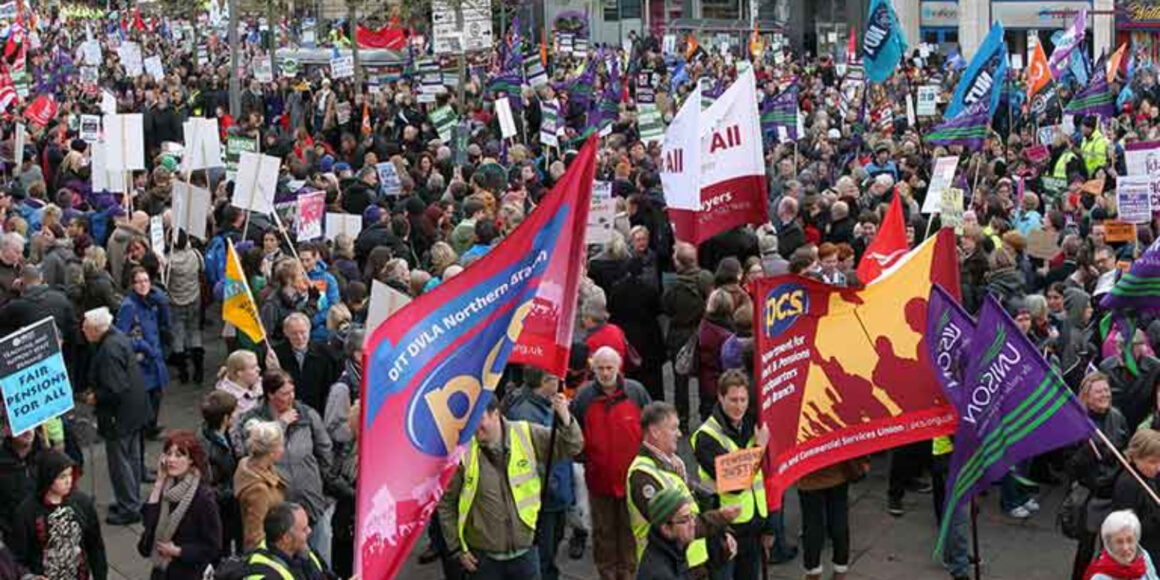

By George Banks
After decades of historically low levels of industrial action, the working class has burst dramatically back onto the political scene. Alongside many disconnected private sector strikes, the main action has been in the public sector – NHS, schools, the civil service – and those privatised services, such as the universities, railways and Royal Mail.
Between June 2022 and June 2023 nearly 4 million working days were lost to strike action, as workers fought to limit the impact of inflation on their pay, as well as to prevent or reverse the neoliberal ‘reforms’ which have intensified their working conditions and defunded public services. On the first day of the RMT strike that launched the strike wave, more workers walked out than all strikers in the preceding year.
Despite heroic efforts by rank and file union members and enthusiasm for the strikes amongst the wider working class, union bureaucrats, both left and right, have held back the struggle at every stage. Almost across the board the union leaders have employed a strategy of occasional and partial strikes, failing to keep up the pressure on government and employers, failing to coordinate across unions even within the same sector.
They also suppressed enthusiastic strike support initiatives such as Enough is Enough, which the RMT and CWU tops set up but quickly abandoned despite its broad appeal. Militant rhetoric was followed by a swift retreat to the boardroom, for hurried secret talks with the bosses. The result of all this has been deals which, given the rate of inflation, amount to real pay cuts, partially funded from existing budgets, while terms and conditions continue to be eroded.
While workers should take pride in their struggle, without which the damage would have been significantly worse, with a more aggressive industrial strategy more could have been won. This disconnect between what was possible and what was achieved and the chicanery employed to push rotten deals over the line have opened up a rift between the activists and the union leaders. It has exposed that the interests of the bureaucrats, even left-talking leaders like Mick Lynch and Dave Ward, will always clash with the interests of the workers at the decisive moment.
The reason for this lies in the nature of the union bureaucracy itself, which acts as a mediator between capitalists and workers. The officials are employed to articulate workers’ anger, but because of this they constantly come under pressure from the capitalists to diffuse that anger and settle at any cost, no matter how far any deal is from the members’ goals. For this they are handsomely rewarded with six-figure salaries, cushy positions, and the opportunity to rub shoulders with the bosses.
As a result of these betrayals, union militants, many of them first time strikers, are now seeking answers as to what went wrong, and what can be done to prevent a similar outcome when conflict flares up again. In this context, we urge all union activists to attend the Workers Summit on 23 September.
Workers Summit
Despite the weaknesses of the SWPs politics (see page 4) their shift towards a rank and file orientation can only be welcomed. Building on the various ‘vote no’ campaigns among health workers, posties and teachers, there is a possibility to launch a serious rank and file initiative.
However, the Summit is not the only game in town. Counterfire launched its ‘own’ Rank and File Combine in June and the Troublemakers at Work conference in July has also expressed a desire to find a ‘niche’ where it can carry out work independent of other, broader forces. To make the most of the opportunity presented to the left we must break down the mutual mistrust and the striving to make gains for each individual organisation at the expense of the others.
We all agree that the rank and file needs to organise independently of the bureaucrats. However, building separate rank and file initiatives is a flawed strategy. At best it keeps activists, even from the same union and sector, away from others who share the same goal. At worst these initiatives will compete with each other and needless division could become embedded, as they are among the left in the RMT, PCS and elsewhere.
Workers Power, through its representatives on the Troublemakers at Work steering committee, has supported the appeal from Brent Trades Council for coordination between the organisations. We will take this message into the Workers’ Summit as well.
Thousands of militants in the various rejectionist campaigns, like NHS Workers Say No, in the healthier Broad Lefts and in the strike support committees need unity in action and clarity of perspective. Only by assembling as many of them as possible in the same, democratic and fighting organisation, can they push back against the union leaders and officials, who will do everything in their power to calm things down in order not to embarrass the Labour Party in an election year.
The reawakening of industrial militancy among the British working class is a historic moment, bigger than any one far left organisation. If we are serious about building a rank and file movement which can pose itself as an alternative leadership to the trade union bureaucracies and wrest control of the disputes away from them, a united front is required.
This is not a plea to blunt the edge of the emerging movement’s cutting politics, but rather a means to sharpen the blade through honest debate and democratic decision making. To halt the decline of our movement and rebuild the unions on a new, class struggle footing, spreading them into every workplace and sector, we need to put aside petty wrangling and unite our forces.